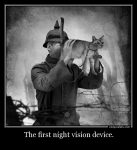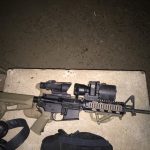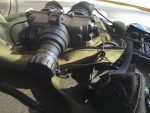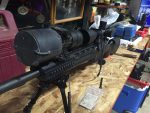I remember as a young man I spent a considerable amount of time hiking, backpacking, and camping in the mountains, usually by myself. Getting away from it all and honing my skills of self-reliance at the same time has always appealed to me. Maybe it is something, on a primal level, relating back to my cave man ancestry.
Senses Go Into Overdrive
It has been my experience that anytime you are completely alone that your awareness and senses go into overdrive, bombarding you with all sorts of new stimuli. At times, this can become overwhelming, and I would be lying if I stated that I have never had the hair on the back of my neck stand up when I was deep in the woods all by myself.
Once Upon A Time
Once upon a time when I believe I was 17, I had parked my truck at the base of the Powder Horn Primitive area outside of Gunnison, Colorado. On paper it appeared to be about a nine mile hike, and I got out of my Ford Ranger and began walking. About two hours into it, I had only made about 2.5 miles and was already experiencing leg cramps, which was not a very good omen. My plan was to make it all the way to the highest of three mountain lakes and then camp and fish for a few days.
Another couple of hours and I was about six miles into my nine-mile hike and completely exhausted. My pack was a heavy 80 plus pounds, and I was feeling every single ounce of it. I had also picked up a tail at some point and I had no idea whether it was friendly or not. I kind of assumed it was likely a dog someone had abandoned or that had run off and got lost, but whatever it was it moved when I moved and stopped when I stopped. [2]
[2]
Unnerving Story Continued Through Night
Yes, it was unnerving to say the least. Finally, at around 1800 hours, I made it to the third mountain lake, totally spent. I chose not to pitch my tent, since I was completely exhausted. So, I stretched a tarp between a couple of trees and built a quick fire. With a couple of canteens full of mountain spring water and a full belly of Top Ramen (yuck) I was lying/dozing off when I heard the crack of a branch being stepped on in the black woods behind me. [3]
[3]
I told myself that it was likely an elk or deer walking through and stepping on a branch. At least, that was the happy version. That was one of the longest nights of my entire life, wondering what was out there in the darkness circling my camp. I honestly think I was being stalked by something, whether wild dogs, wolves, a mountain lion, who knows for sure. I never did get a clear look at anything, but I heard numerous low guttural snarls and growls all night long.
It is amazing how the night swallows up your flashlight beam, and that night I had a 3D cell mag lite [4] with me that didn’t shine very far into the deep shadows of that moonless night. I wasn’t completely helpless in the face of whatever was out there. I did have my fixed blade Kabar Marine combat knife [5] and my 1911 .45 acp. The 1911 was loved dearly, but I wouldn’t have actually wanted to shoot a charging bear with it, as it has way too many sharp edges on it in case the bear took it away from me and shoved it somewhere tender, lol!
Need For A Night Vision Scope
What I really needed that night was a night vision scope. Then I could have seen what danger was lurking there in the darkness.
First Infrared Night Vision Scopes
US Night vision devices have been around since the end of World War II with the advent of the American Military’s first active infrared night vision scope. This first unit utilized a huge dish shaped infrared light transmitter that beamed invisible light out into the darkness that the scope could pick up, thus illuminating whatever you were looking at. Range on these earliest devices was only about 150 yards, but they did in fact work. The battery life wasn’t very long at approximately 40 minutes for continuous use, but they would give you a sizable tactical advantage over anyone who didn’t have one of these scopes. This infrared beam was invisible to the naked eye, making it a great tactical advantage in combat. [6]
[6]
The German Military beat us to the punch by a full six years, developing their own active infrared night vision scope as early as 1939 with a range of approximately 600 meters by 1943. One of the huge challenges of these systems were the huge battery packs that were required to power the units, making them difficult to use.
These systems use an anode in conjunction with the cathode to accelerate the electrons. Another problem with that approach was that the acceleration of the electrons distorts the image and greatly decreases the life of the tube. Furthermore this technology in its original military use was quickly duplicated by hostile nations, which allowed enemy soldiers to use their own NVDs to see the infrared beam projected by the device. Sometimes you will hear active infrared systems referred to as Generation 0 night vision.  [7]
[7]
Gen 1 Night Vision Device (NVD)
The next generation of NVDs moved away from active infrared, using passive infrared instead. Once dubbed Starlight by the U.S. Army, these NVDs use ambient light provided by the moon and stars to augment the normal amounts of reflected infrared in the environment. This means that they did not require a source of projected infrared light. This also means that they did not work very well on cloudy or moonless nights. Generation-1 NVDs use the same image-intensifier tube technology as Generation 0, with both cathode and anode, so image distortion and short tube life are still a problem.
Gen 1 NVDs are pretty inexpensive these days, and readers are forewarned that a lot of Russian import NVDs that claim to be Gen 2 and Gen 3 tubes are really only U.S. Gen 1 tube spec. Another problem with Gen 1 NVDs is that they are extremely susceptible to damage from unexpected bright lights, such as a searchlight or even car headlights, if they are directly into the unit. Even if they aren’t damaged by sudden bright lights, they bloom pretty bad from excess bright light. Range of these units are usually 75 to 100 yards, and tube life is only around 1,500 hours.
Affordability sums up Gen 1 NVDs. It gets you some night time capability, and obviously some night vision is always better than no night vision. Is it the latest and greatest? No, in fact, Generation 1 technology dates back to the early 1960’s. That’s when a computer was the size of a small house and 20 plus years before cell phones were even invented. Examples: AN/PVS-2 Starlight scope and PNV-57A Tanker goggles. Gen 1 is hard for me to recommend that anyone actually purchase one of these to defend your life and homestead with, but they are better than having early night vision equipment, lol.
Gen 2 Night Vision Device (NVD)
Major improvements in image-intensifier tubes resulted in Generation-2 NVDs. They offer improved resolution and performance over Generation-1 devices and are considerably more reliable. The biggest gain in Generation 2 is the ability to see in extremely low light conditions, such as a moonless night. This increased sensitivity is due to the addition of the microchannel plate to the image-intensifier tube.  [8]
[8]
Since the MCP actually increases the number of electrons, instead of just accelerating the original ones, the images are significantly less distorted and brighter than earlier-generation NVDs. Gen 2 tubes last considerably longer than Gen 1 tubes and are generally more durable. Tube life of Gen 2 tubes last over three times as long as Gen 1, or around 5,000 hours. More expensive than Gen 1, the performance is noticeably better and well worth the extra capital required. I would recommend first time NVD purchasers check out Gen 2 and Gen 2+ units as a starting point.
Gen 2+ devices are better units than the earlier Gen 2 units. Enhanced performance and the ability to provide increased recognition ranges in lower levels of light are what you are purchasing over Gen 2. Pretty much everyone sells them these days, and U.S. devices will contain tubes made by ITT, Litton etc… Check Cabela’s, Bass Pro, and Sportsman’s guide for these entry level units. Examples: AN/PVS-4, AN/PVS-5, SUPERGEN, PNV-57E [9].
Gen 3 Night Vision Device (NVD)
Generation 3 is currently used by the U.S. military. While there are no substantial changes in the underlying technology from Generation 2, these NVDs have even better resolution and sensitivity. This is because the photo cathode is made using gallium arsenide, which is very efficient at converting photons to electrons. Additionally, the MCP is coated with an ion barrier, which dramatically increases the life of the tube, up to 10,000 plus hours for some tubes. One of the key specs to look for is the line pair per millimeter rating of the NVD. The higher quality units will have 64 lp/mm or greater. This rating is generally indicative of the quality of the tube you are getting. However, lp/mm is only one of three important specifications you will want to check into. Examples: AN/PVS-7, AN/NVS-7, AN/PVS-10, AN/PVS-14, AN/PNVS-14, CNVS-4949, and PN-21K [10]
[10]
Gen 4 Night Vision Device (Gen 3 Auto Gated NVD)
This is a tricky one, as technically there is not really a Gen 4 classification, according to the U.S. Army. When it was initially introduced the U.S. Army recognized the Gen 4 technology classification. However, after testing reliability and life span of the Gen 4, the Army determined that this technology did not meet their strict requirements and thus recanted the Gen 4 definition. So what does this mean for someone looking for the best equipment they can get? In terms of performance, Generation 4 equipment is only marginally equivalent to or slightly better than most Gen 3 autogated NVDs.
However, the very nature of the 4th Generation technology makes it more prone to failures and reduces its life expectancy as compared to quality Gen 3 equipment. Pinnacle tube Gen 3 autogated models offer the NVD user spectacular performance, much better tube longevity, increased reliability, and a lower investment cost. Although some people feel that Gen 4 gives a little better image, it is really a bit of a toss up, and it often comes down to which unit has the better individual image tube. Gen 4 tubes simply do not deliver, and even if you can find an authentic Gen 4 NVD, I do not recommend purchasing. The questionable increase in performance is more than off-set by all the negative aspects of a thin or completely removed ion barrier. Examples: Gen 3 pinnacle auto gated tube AN/PVS-22, NVS-22  [11]
[11]
Tomorrow, I’ll write about understanding the resolution and signal-to-noise specifications of night vision devices.
See Also:
- Stalking the Night- Part 2, by Mark B. [12] (Active on 10/15/17)
SurvivalBlog Writing Contest
This has been part one of a two part entry for Round 73 of the SurvivalBlog non-fiction writing contest [13]. The nearly $11,000 worth of prizes for this round include:
First Prize:
- A $3000 gift certificate towards a Sol-Ark Solar Generator from Veteran owned Portable Solar LLC. The only EMP Hardened Solar Generator System available to the public.
- A Gunsite Academy Three Day Course Certificate. This can be used for any one, two, or three day course (a $1,090 value),
- A course certificate from onPoint Tactical for the prize winner’s choice of three-day civilian courses [14], excluding those restricted for military or government teams. Three day onPoint courses normally cost $795,
- DRD Tactical is providing a 5.56 NATO QD Billet upper [15]. These have hammer forged, chrome-lined barrels and a hard case, to go with your own AR lower. It will allow any standard AR-type rifle to have a quick change barrel. This can be assembled in less than one minute without the use of any tools. It also provides a compact carry capability in a hard case or in 3-day pack (an $1,100 value),
- Two cases of Mountain House freeze-dried assorted entrees [16] in #10 cans, courtesy of Ready Made Resources (a $350 value),
- A $250 gift certificate good for any product [17] from Sunflower Ammo,
- American Gunsmithing Institute (AGI) is providing a $300 certificate good towards any of their DVD training courses [18], and
- Two cases of Meals, Ready to Eat (MREs), courtesy of CampingSurvival.com (a $180 value).
Second Prize:
- A Model 175 Series Solar Generator provided by Quantum Harvest LLC (a $439 value),
- A Glock form factor SIRT laser training pistol and a SIRT AR-15/M4 [19] Laser Training Bolt, courtesy of Next Level Training, which have a combined retail value of $589,
- A gift certificate for any two or three-day class from Max Velocity Tactical (a $600 value),
- A transferable certificate for a two-day Ultimate Bug Out Course from Florida Firearms Training (a $400 value),
- A Trekker IV™ Four-Person Emergency Kit from Emergency Essentials (a $250 value),
- A $200 gift certificate good towards any books published by PrepperPress.com,
- A pre-selected assortment of military surplus gear from CJL Enterprize (a $300 value),
- RepackBox is providing a $300 gift certificate to their site.
Third Prize:
- A Royal Berkey water filter, courtesy of [20] Directive 21 (a $275 value),
- A large handmade clothes drying rack, a washboard, and a Homesteading for Beginners DVD, all courtesy of The Homestead Store, with a combined value of $206,
- Expanded sets of both washable feminine pads and liners, donated by Naturally Cozy (a $185 retail value),
- Two Super Survival Pack seed collections [21], a $150 value, courtesy of Seed for Security, LLC,
- Mayflower Trading is donating a $200 gift certificate for homesteading appliances,
- Two 1,000-foot spools of full mil-spec U.S.-made 750 paracord [22] (in-stock colors only) from www.TOUGHGRID.com (a $240 value), and
Round 73 ends on November 30th, so get busy writing and e-mail [23] us your entry. Remember that there is a 1,500-word minimum, and that articles on practical “how to” skills for survival have an advantage in the judging.

Comments Disabled To "Stalking the Night- Part 1, by Mark B."
#1 Comment By Jesse Davis On October 14, 2017 @ 10:52 am
When I was in Iraq we liked to use our NVGs in conjunction with flashlights with infrared filters. We could point the light in windows and alleys and see without the enemy knowing.
#2 Comment By Butch On October 14, 2017 @ 3:50 pm
Jesse, do you know where we can get IR filters for flashlights?
#3 Comment By Butch On October 14, 2017 @ 4:24 pm
Should have done my homework before asking :). Lots of IR illumination gear out there.
#4 Comment By Retired cop On October 14, 2017 @ 12:36 pm
Would you please also discuss the current trend of identifying some night vision products as “digital or digitally enhanced” or electronically enhanced”? Is this actually a different type of night vision of just a gussied up version of an earlier type? They seem to have gps, digital photography and other add ons, but frequently don’t talk about gen 1, gen2, or technical info such as lp/mm, or maybe rates that you see on gen 1 and 2 items. Great article, btw, and timely. Thanks,
#5 Comment By Retired cop On October 14, 2017 @ 12:38 pm
That should read mghz rates in last line, not “maybe rates”, I hate auto correct! Thanks,
#6 Comment By R. Henry On October 14, 2017 @ 12:48 pm
Retired cop- yes different type, more like a camera than a true NV device.
#7 Comment By GWH On October 14, 2017 @ 12:56 pm
Reminds me of an account told by my brother. Alone in the North Cascades in the middle of the night. He heard heavy breathing (no gun) so he froze deep into his sleeping bag. Heavy foot steps and then he was picked up in the bag and shook by something with TWO hands. He was dropped to the ground and heavy footsteps walked away. My brother is not a fabricator of stories. There IS something out there in the dark. Be afraid…very afraid.
#8 Comment By MAS On October 14, 2017 @ 2:47 pm
Maybe it was a caveman…love a good campfire tale.
#9 Comment By GoneWithTheWind On October 14, 2017 @ 3:37 pm
I like the dark. I too admit to a few camping hiking trips where as darkness surrounded me I felt alone and vulnerable. A normal reaction and one that once accepted and understood can be kept under control. I have hiked in the wilderness at night and have some suggestions: attach a glow stick to the end of a two foot long stick. Hold this down and just in front of you while walking and you can see the trail and any obstacles. To better protect your night vision place a barrier between the glow stick and where it attaches to keep the light from directly hitting your eyes. Wear safety glasses to protect from the occasional twig/branch you might encounter. A hat is good to also protect your noggin from branches. Buy an eye patch from your local pharmacy and wear it all day and night. Only remove it in darkness and even then briefly to protect that acquired night vision. This works, it gets even better after about three days. It isn’t nearly as good as night vision devices but it is cheaper, always available, doesn’t require batteries and doesn’t reduce your natural night vision when used.
#10 Comment By Blackcat On October 15, 2017 @ 3:16 am
The champion of hide and seek was near you that night most likely.
#11 Comment By Wheatley Fisher On October 15, 2017 @ 5:17 am
I got to live in the Powderhorn Primitive area one summer. But I used 2 horses. Best job I ever had. Only had 2 dozen visitors use any of the 40,000 acre area that whole summer, as 11,400 feet elevation at the highest plateau separates the hardy from those of lesser fitness.
#12 Comment By mophead On October 15, 2017 @ 1:46 pm
Just have to comment on the pic of ‘first night vision device’. I am LMAO!
#13 Comment By Bwhntr62 On October 15, 2017 @ 11:26 pm
Now I agree these GEN 3 type devices are excellent, but pricey. I have a Sightmark Photon XT 4.6 power IR NVD. True it has its own IR illuminator, which makes it vulnerable to anyone on the other end with a IR detector. But the price was only 450.00 and it uses AA batteries. I have made out people and animals easily at 160 yards when mounted on my Remington R-15 ( really an AR ). I guess it just depends on who you think your potential adversaries are going to be. If it is any unit of our current spec ops or even regular army/ marine troops you are screwed, I don’t care what goodies you or your group has. But My group is likely to be faced by inner city gangs, who are raiding the more affluent sunburbs when they run out of places to loot in the city. They are unlikely to even know what an IR or NVD is, much less defend against it. Of far more important ace would be vigilant night guards who will warn of any attempted intrusion and allow your defense team to react and gain the upper hand. A few shots out of the dead of night that hit home will likely cause these predatory punks to flee immediately.